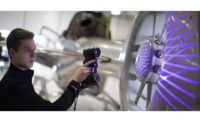Quality Control With 3D Scanning
3D scanners are quick, accurate and record mass amounts of geometry, making them less laborious and more flexible than basic metrology tools.

Manufacturers use 3D scanning to speed up their quality control processes. That’s because when it comes to comparing data or making quick quality checks of end products, machines are faster than humans.
3D scanners enable non-contact, highly precise 3D profile measurements. They come with automation features for complicated settings, allowing for unvarying measurements between operators.
Handheld 3D scanning technologies are key for industrial quality control operations. These technologies can record an object’s geometry and turn those measurements into data such as a triangle mesh or point cloud.
3D scanners are quick, accurate and record mass amounts of geometry, making them less laborious and more flexible than basic metrology tools.
Automated 3D scanning, using a robotic arm, can do wonders for quality control. It captures information rapidly and is flexible. For instance, it can easily perform quality control checks on conveyor belts.
Automated solutions: Programmed vs Pre-programmed modes
Some 3D scanning solutions have what’s called an autonomous mode, where the scanner and robot arm scan an object without a pre-programmed course. The scanner’s software examines scanned surfaces to decide if all essential data has been captured and, reroutes the scanner to fill in missing data if needed. This mode is mostly valuable for examining large sets of differing objects.
Programmed modes, however, are most effective for scanning large amounts of similar parts. Some software even lets operators physically guide scanners across the measured object, to teach it how to scan in the future.
Reverse engineering
3D scanning can reverse engineer tooling to yield CAD data, complete intermittent quality controls, and quickly resolve errors. It can also reverse engineer products to help engineers discover a part’s volume measurements and capture motion and environment information for various applications across gaming, retail, aerospace, and numerous other industries.
Such scanners are often handheld, which makes it easy for operators to use multiple scanners at once, typically for 3D printing purposes.
The benefits of 3D measurement are numerous, and the technology continues to improve. Most arms have become lighter, faster, and more effective, as OEMs push their capabilities each year.
3D scanning has many other benefits. It helps manufacturers advance their designs, and makes it easier for businesses gather data, including information on development times. It also rapidly and thoroughly examines complex surfaces, refining design quality.
As the manufacturing industry continues to embrace smart factories, quality control remains as important as ever. Therefore, high-speed, high-accuracy, and flexible 3D scanners are key to mass production.
The demand for handheld scanners continues to grow, as businesses want rapid 3D data collection for product development and analysis.
Looking for a reprint of this article?
From high-res PDFs to custom plaques, order your copy today!






